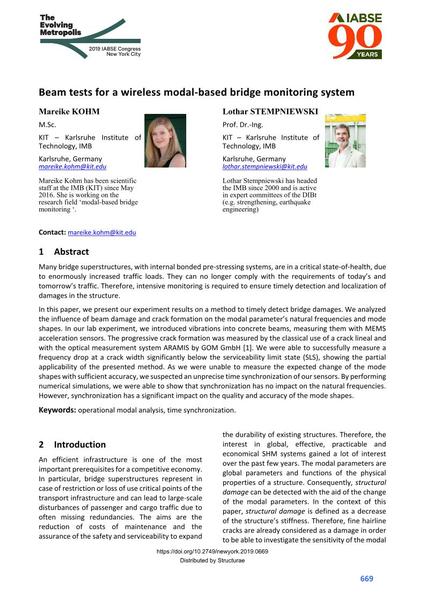Beam tests for a wireless modal-based bridge monitoring system

|
|
|||||||||||
Bibliographic Details
| Author(s): |
Mareike Kohm
(KIT – Karlsruhe Institute of Technology, IMB)
Lothar Stempniewski (KIT – Karlsruhe Institute of Technology, IMB) |
||||
|---|---|---|---|---|---|
| Medium: | conference paper | ||||
| Language(s): | English | ||||
| Conference: | IABSE Congress: The Evolving Metropolis, New York, NY, USA, 4-6 September 2019 | ||||
| Published in: | The Evolving Metropolis | ||||
|
|||||
| Page(s): | 669-674 | ||||
| Total no. of pages: | 6 | ||||
| DOI: | 10.2749/newyork.2019.0669 | ||||
| Abstract: |
Many bridge superstructures, with internal bonded pre-stressing systems, are in a critical state-of-health, due to enormously increased traffic loads. They can no longer comply with the requirements of today’s and tomorrow’s traffic. Therefore, intensive monitoring is required to ensure timely detection and localization of damages in the structure. In this paper, we present our experiment results on a method to timely detect bridge damages. We analyzed the influence of beam damage and crack formation on the modal parameter’s natural frequencies and mode shapes. In our lab experiment, we introduced vibrations into concrete beams, measuring them with MEMS acceleration sensors. The progressive crack formation was measured by the classical use of a crack lineal and with the optical measurement system ARAMIS by GOM GmbH [1]. We were able to successfully measure a frequency drop at a crack width significantly below the serviceability limit state (SLS), showing the partial applicability of the presented method. As we were unable to measure the expected change of the mode shapes with sufficient accuracy, we suspected an unprecise time synchronization of our sensors. By performing numerical simulations, we were able to show that synchronization has no impact on the natural frequencies. However, synchronization has a significant impact on the quality and accuracy of the mode shapes. |
||||
| Keywords: |
operational modal analysis time synchronization
|
||||
